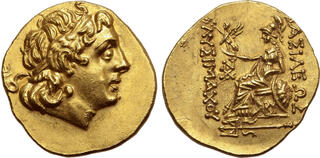| Roma Numismatics Ltd > Auction XXX | Auction date: 21 March 2024 |
| Lot number: 179 Price realized: 7,500 GBP (Approx. 9,501 USD / 8,747 EUR) Note: Prices do not include buyer's fees. | Show similar lots on CoinArchives Find similar lots in upcoming auctions on |
| Lot description: Kings of Thrace, Lysimachos AV Stater. Byzantion, 305-281 BC. Diademed head of the deified Alexander to right, with horn of Ammon / Athena Nikephoros seated to left, resting left arm on shield, transverse spear in background; ΒΑΣΙΛΕΩΣ to right, ΛΥΣΙΜΑΧΟΥ crowned by Nike to left, monogram in left field, BY below throne, trident in exergue. Price -; Müller -, cf. 231 (tetradrachm with this monogram); Marinescu Issue 135, 453 (O174/R432); A. Zograph, The Tooapse Hoard, NC 1925, illustration on p.29 (same dies); CNG Triton VI, 228 (same dies). 8.47g, 21mm, 12h. Mint State; a wonderful example. Extremely rare with this monogram. Ex Nomos AG, Auction 25, 20 November 2022, lot 78 (hammer: CHF 11,000); Ex collection of a Nobleman (†1940) and "undoubtedly from the Tuapse (Tooapse) Hoard of 1908 (IGCH 1120)" - Nomos. "One of the most remarkable of the 'Successors' of Alexander" in the words of D. Sear, Lysimachos became King of Thrace in 306 BC, following a period of personal service to Alexander as somatophylax (bodyguard) to the famous conqueror (Sear, Greek Coins and Their Values, Volume 2, 1978, p. 634). According to Justin, Lysimachos gained favour with Alexander, despite disobeying the Macedonian king in assisting condemned philosopher Kallisthenes, when he proved himself capable of killing a lion with his bare hands (Justin, Epitome of Pompey Trogue's "Philippic histories", 15.3). For such a feat, which was also narrated by Pausanias, Lysimachos was "exalted far above any nobility of birth by the proofs which he had given of personal merit" (Pausanias, Description of Greece, 1.9.5; Justin, Epitome of Pompey Trogue's "Philippic histories", 15.3). A lion head appears on the shield of Athena Nikephoros on this coin reverse and Lysimachos adopted the front part of a lion as a numismatic symbol above the monogram on many of his coins (e.g. silver drachm, Thompson 65), perhaps alluding to this story of his heroic strength and bravery. Types like this beautifully detailed stater stand out among the coinages of the Diadochi due to the obverse portrait: the Thracian king continued to feature Alexander on his gold staters and silver tetradrachms even after the other Diadochi had ceased to depict Alexander. Lysimachos' coinage represents Alexander as a distinguished and deified figure, his diadem and ram's horns signifying his royal and divine status as king and son of Zeus Ammon. K. Dahmen identifies this notable numismatic design as an assertion of Lysimachos' particular legitimacy as a successor to Alexander, elevating the living Lysimachos by association with the qualities of the late Macedonian conqueror (Dahmen, The Legend of Alexander the Great on Greek and Roman Coins, 2007, p.17). The reverse imagery attests to the Thracian king's personal successes: the depiction of the war goddess Athena, with her Nike attribute crowning Lysimachos' inscribed name, can be understood to refer to the king's military achievements, specifically perhaps the Battle at Ipsos in 301 BC (O. Morkholm, Early Hellenistic Coinage from the Accession of Alexander to the Peace of Apamea, 1991, p.81). Estimate: 8000 GBP |  |


